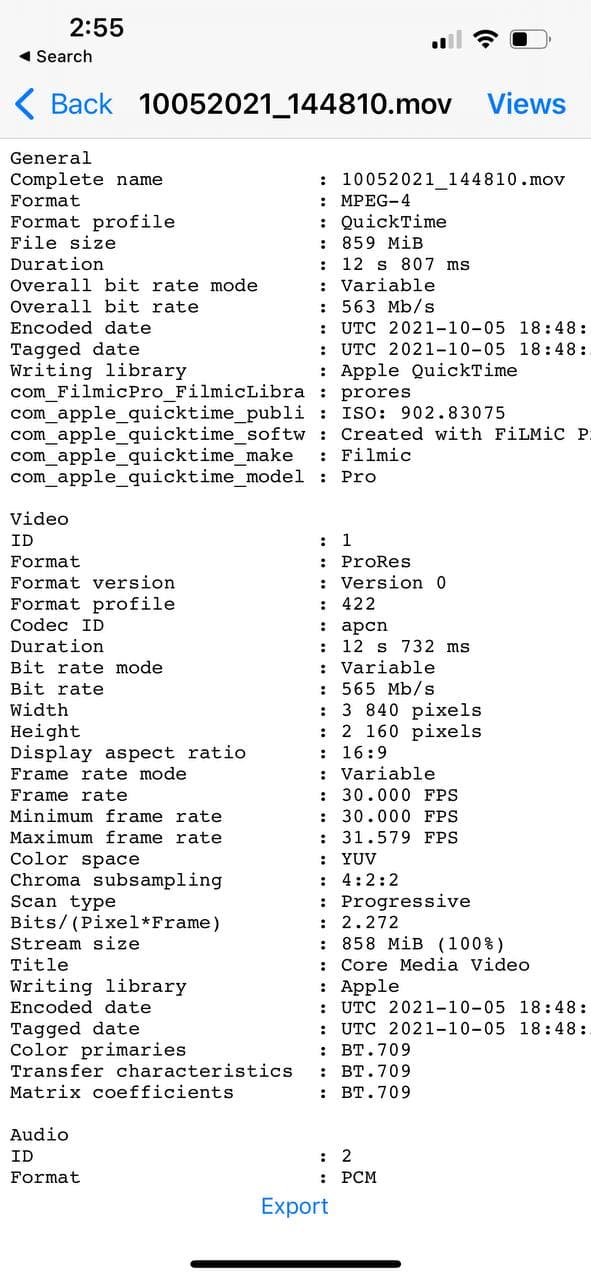On September 16, 2021, I published: iPhone 13 ProRes — 6 questions for Apple. Those questions were about whether the framerates are CFR (constant framerate) or VFR (variable framerate) and which ones are available. The majority of those questions have now been answered, although not by Apple. Instead, both FiLMiC Pro and photographer/cinematographer Carolina Bonnelly of BonnellyFilms.com have answered on Apple’s behalf. In fact, Carolina even sent me screenshots to prove and illustrate the results. Carolina’s tests were both recorded with FiLMiC Pro in her new iPhone 13 Pro camera/recorder which also happens to be a smartphone too, one at ProRes 422 and the others using ProRes 422 (HQ).
Past articles covering VFR and CFR
Here is a link to prior articles covering the differences between CFR (constant framerate), VFR (variable framerate) and how to handle them in post.
Screenshots courtesy of Carolina Bonnelly

Carolina Bonnelly of BonnellyFilms.com sent me the screenshots done with either MediaInfo or Invisor, an app I covered in Review: Invisor media file inspector for macOS in September 2020. Invisor and MediaInfo are among the very few tools that can explicitly show whether a file was recorded as CFR or VFR and at what rate.
As I have covered in several past articles, so far FiLMiC Pro has exclusively recorded VFR files. That has also been the case with the native Apple Camera app. Carolina has proven that nothing has changed with ProRes, as you’ll see below.

Now we know that everything is still VFR, variable framerate.
Refresher about how to handle VFR footage in post
Always set the desired framerate manually in your video editor when creating the project, be it an integer rate, like exact 24, exact 25, or exact 50… or a non-integer rate like 23.976, 29.97 or 59.94. (Never let the editor decide the rate automatically, based upon the first clip placed in the timeline, especially when it has been shot in VFR.) That way, any modern editor that handles VFR raw footage will conform it properly to the desired delivery rate.
Conclusions
Thanks to FiLMiC for supporting ProRes 422 so quickly in FiLMIC Pro and to Carolina Bonnelly of BonnellyFilms.com. Thanks also to Carolina for sending the screenshots to illustrate the situation.
(Re-)Subscribe for upcoming articles, reviews, radio shows, books and seminars/webinars
Stand by for upcoming articles, reviews, books and courses by subscribing to my bulletins.
In English:
- Email bulletins, bulletins.AllanTepper.com
- In Telegram, t.me/TecnoTurBulletins
- Twitter (bilingual), AllanLTepper
En castellano:
- Boletines por correo electrónico, boletines.AllanTepper.com
- En Telegram, t.me/boletinesdeAllan
- Twitter (bilingüe), AllanLTepper
Most of my current books are at books.AllanTepper.com, and also visit AllanTepper.com and radio.AllanTepper.com.
FTC disclosure
There is currently no financial relationship between FiLMiC and Allan Tépper or TecnoTur LLC. BonnellyFilms.com is a consulting and web hosting client of TecnoTur.us. Some of the other manufacturers listed above have contracted Tépper and/or TecnoTur LLC to carry out consulting and/or translations/localizations/transcreations. Many of the manufacturers listed above have sent Allan Tépper review units. So far, none of the manufacturers listed above is/are sponsors of the TecnoTur, BeyondPodcasting, CapicúaFM , SpeakCastilian or TuSaludSecreta programs, although they are welcome to do so, and some are, may be (or may have been) sponsors of ProVideo Coalition magazine. Some links to third parties listed in this article and/or on this web page may indirectly benefit TecnoTur LLC via affiliate programs. Allan Tépper’s opinions are his own. Allan Tépper is not liable for misuse or misunderstanding of information he shares.


